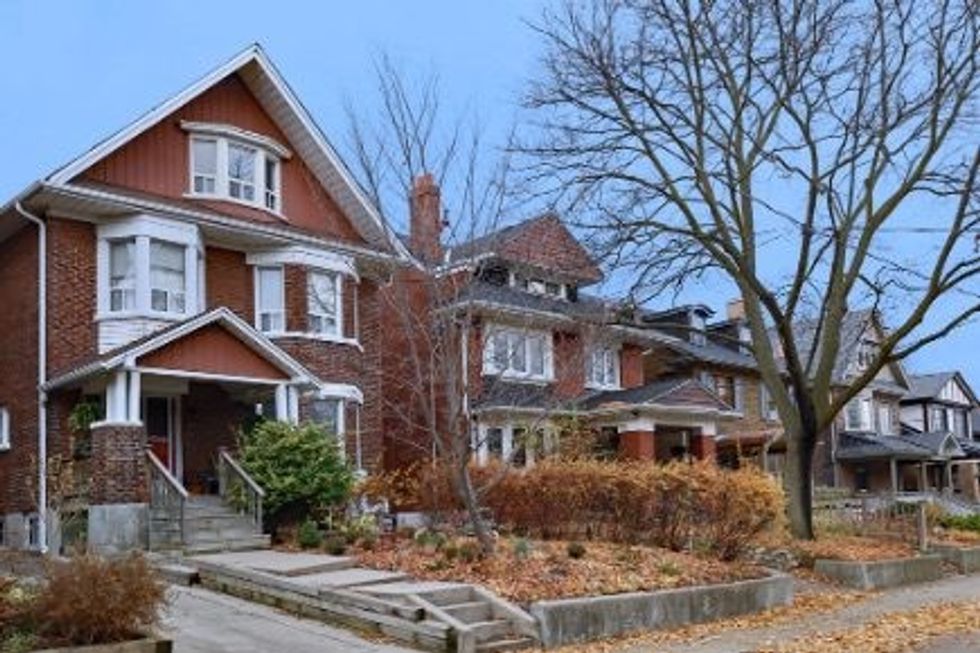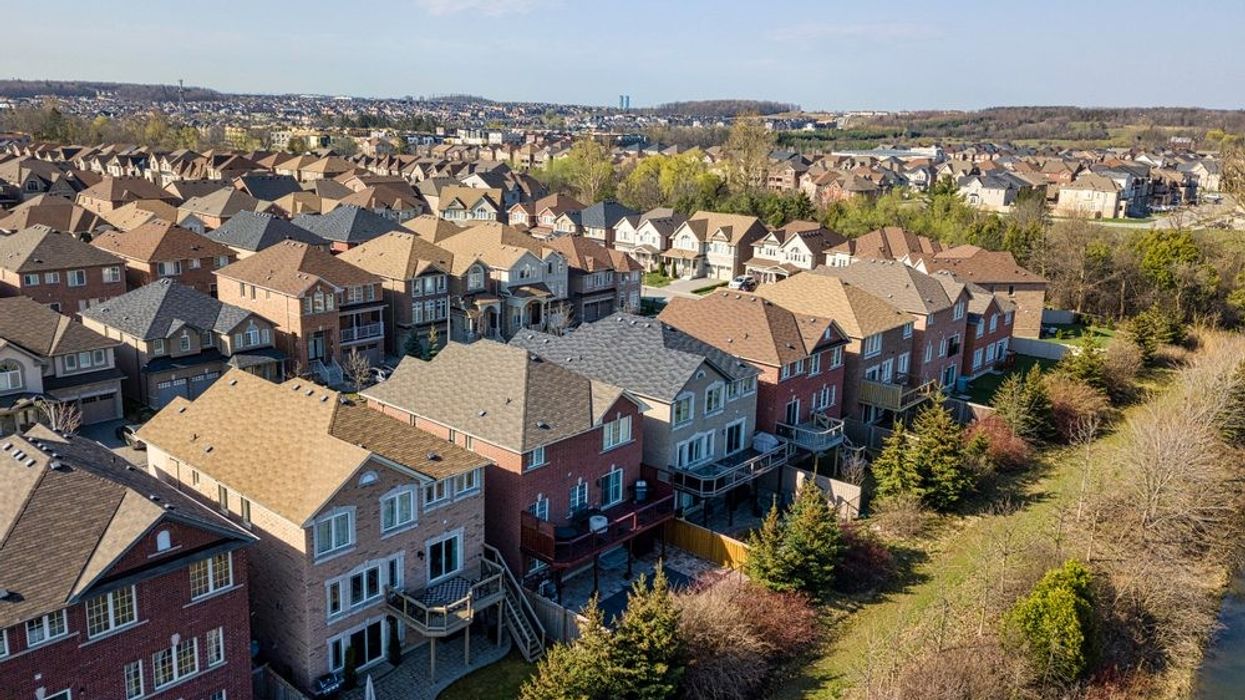Real estate in Richmond Hill is holding its value better than the rest. Brock, not so much.
Last week, Toronto real estate expert John Pasalis released a comprehensive chart outlining the drop in sale prices of low-rise homes in various regions of the Greater Toronto Area, comparing February 2023 sales to those one year prior.
Toronto mortgage broker Ron Butler -- a notoriously tough critic -- called it “the best table on the GTA price fall since the peak in February 2022." Inevitably, Pasalis' findings inspired a conversation on social media about Ontario's dramatic real estate market.
Things have changed drastically within a year. Sky-high interest rates -- which have only just recently seen a break from their perpetual hike -- and home prices that are still a lot higher than they were pre-pandemic in many regions have kept would-be buyers out of the market.
While it’s no surprise that home prices have dropped across the board after a red-hot, pandemic-inspired run that peaked about a year ago, the chart shows dramatic differences in price drops in various regions. The chart clearly illustrates how the biggest drops took place outside of Toronto and fell the least in the downtown core. “This is the precise reverse of the 2021 price run-up,” wrote Butler.
Places like Brock, Caledon, and Pickering -- cities that saw prices surge not long after the onset of the pandemic -- all experienced the greatest price drops between February 2022 and February 2023, at -37%, -36%, and -33%, respectively. During the February 2022 peak, average low-rise home prices in Brock reached a shocking $1,124,119. By February 2023, they had dropped to $713,042. Similarly, in the once red-hot Caledon region, home prices fell from $1,864,257 in February 2022 to $1,120,252 in February 2023.
Never one to hold back, Butler expresses his thoughts on Brock’s price drops. “The idea that a house 1 hour and 15 minute drive from downtown Toronto in Brock Region could be worth $1.1M is peak Batshit Crazy,” he wrote. He’s not wrong. But those were different times.
Meanwhile, Richmond Hill, Toronto, and Vaughan saw the smallest drops in that time frame, at -14%, -15%, and -17%, respectively. Richmond Hill saw a minor price drop relative to some of its big suburbia counterparts. At the February peak, the average low-rise home price hit $1,914,379; by February 2023, prices were $1,644,146. In Toronto, prices in February 2022 had reached $1,889,178 before dropping to $1,606,591 in February 2023. Vaughan saw the third-smallest price drop, from $1,970,730 in February 2022 to $1,643,499 in February 2022.
So, what does this all mean? Clearly, there is a lack of supply of low-rise, single-family homes in Toronto helping to maintain prices. We know that. But does it also reflect a move away from the pandemic-inspired perceived greener pastures offered outside of the city core now that the pandemic is finally in the rearview mirror?
“If you look at that list, generally, you’re seeing the year-over-year price drop is more pronounced in areas further from the City of Toronto, or -- at least -- the central GTA,” says Jason Mercer, Senior Market Analyst at the Toronto Regional Real Estate Board (TRREB). “This suggests that, even in a climate of higher interest rates, closer to the City of Toronto and certainly up the Yonge Street corridor. This is a reverse of the trends we saw back in the earlier pandemic times.”

But there’s more to consider when looking at the figures, he says. Mercer highlights how the character of low-rise differs from one area to the next. “What can be considered low-rise in the City of Toronto can still account for an array of, say, medium density home types,” he says, stating that the type of housing stock can impact the price change reflected in the statistics.
“I’ve seen discussions around places like King City -- and even more suburban or exurban areas -- about price change and there is a compositional element to this too,” says Mercer. “In some areas, you have quite a diverse housing stock that can range from estate-style housing down to more traditional housing developments. If you’re selling more of the latter this year, as opposed to estate-style stuff last year, that can also account for the change.”
That’s not to say the figures aren’t telling. “On one hand, you can look at aggregate average home prices and glean some information, and I think it’s reasonable to say it would suggest we have tighter market conditions closer to the core, but it’s important to note that the mix of homes sold from one year to the next can change, and that can impact your average selling price as well,” says Mercer.
In terms of what areas of Toronto will see the smallest price drops as we move into the spring months, Mercer points to the results of TRREB's latest Ipsos survey, which revealed a potential resurgence of buyers come spring. “Intentions to buy were edging up for 2023, and that will largely be driven by the approved first-time buyer sector,” says Mercer. “If that turns out to be the case, I would be keeping my eyes on the segment of the market that caters to that type of buyer -- condos, townhomes, and stacked townhomes.”
When it comes to specific neighbourhoods, Toronto-based realtor Davelle Morrison says she expects Leslieville to hold its value. “It always hold its value, no matter what is happening -- even in 2008,” says Morrison. Furthermore, she's noticed homes in the city’s top school districts -- Leaside, Midtown, High Park, and Bloor West Village, for example -- hold their value as well.
“One of the tenants of purchasing real estate is ‘location, location, location,’” says Morrison. “It’s not just because I am a City of Toronto dweller that I tell people that the best value for your buck is buying a house in the city. That chart proves it statistically. All of the outlying areas were the ones that had the most dramatic price drops. If you pick a good location, then your real estate value is going to stay higher than other areas. People want to be close to transit and may even be moving back after the pandemic. Overall, if someone is going to have to spend $1.4M on a house, they’d rather do so in Toronto as opposed to in the outlying areas of the city.”
Calling Richmond Hill an “outlier,” Morrison questions whether the relatively low price drop was the result of foreign investment or recent expansions in transit to better serve the region.
When looking at the data, however, Morrison points to some anomalies in certain cities when it comes to the number of sales that occurred. “Toronto has a high number of sales compared to some other regions, so that can skew the data a little, so the chart may not look exactly as it played out,” she says. Morrison also cautions about looking at stats when we went through the major anomaly of the pandemic for two years -- something that shook up the industry like never before.
While the spring real estate market still seems as uncertain as the weather, most experts expect it will start to recover by the second half of the year.
“Once we get more supply on the market, it may satiate the buyers out there; there’s bidding wars right now, but they may calm down,” says Morrison. “Given what’s happening with the global banking situation, all eyes are on the US federal reserve to watch whether they’ll raise rates. If they do, Canada could follow suit. Furthermore, we’re waiting to see if there’s a tightening on mortgage rules.”
So, in the meantime, whether prices drop further as the ground thaws is anyone’s guess -- whether in Brock or Richmond Hill.





















